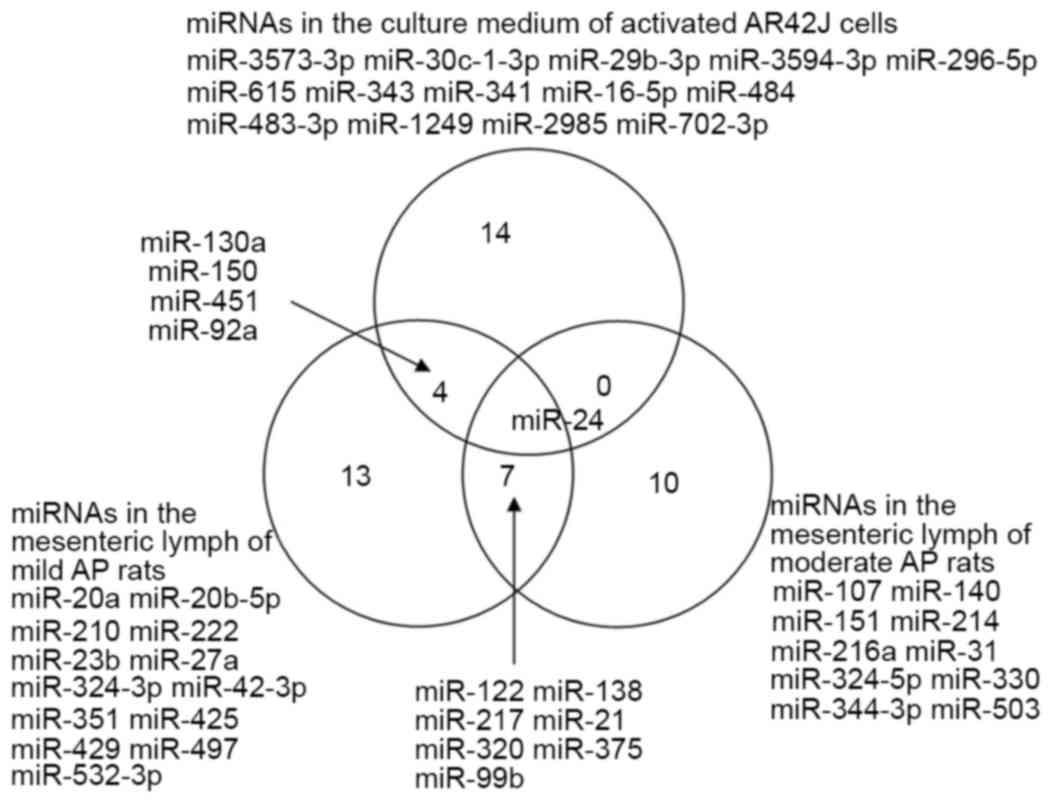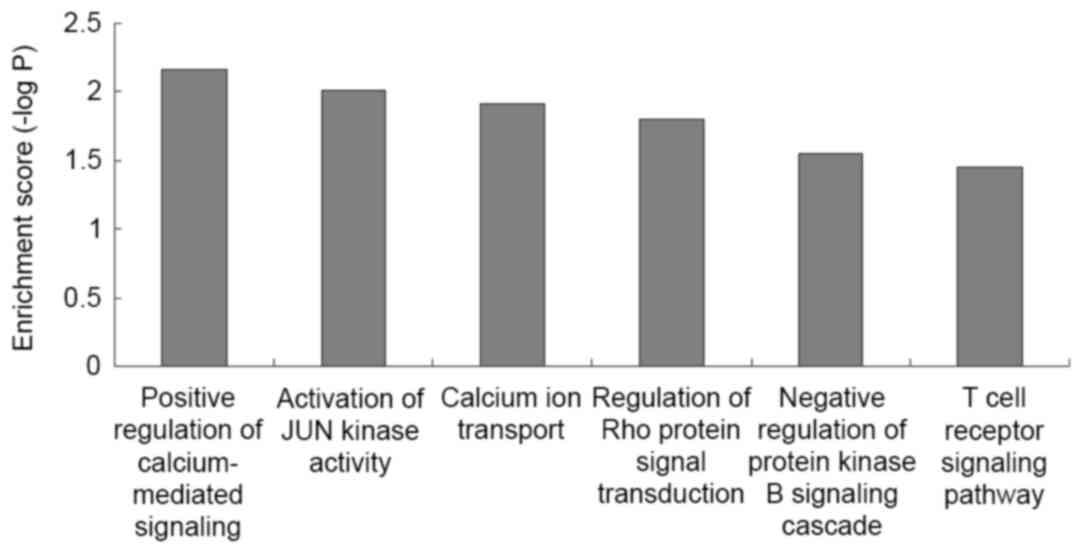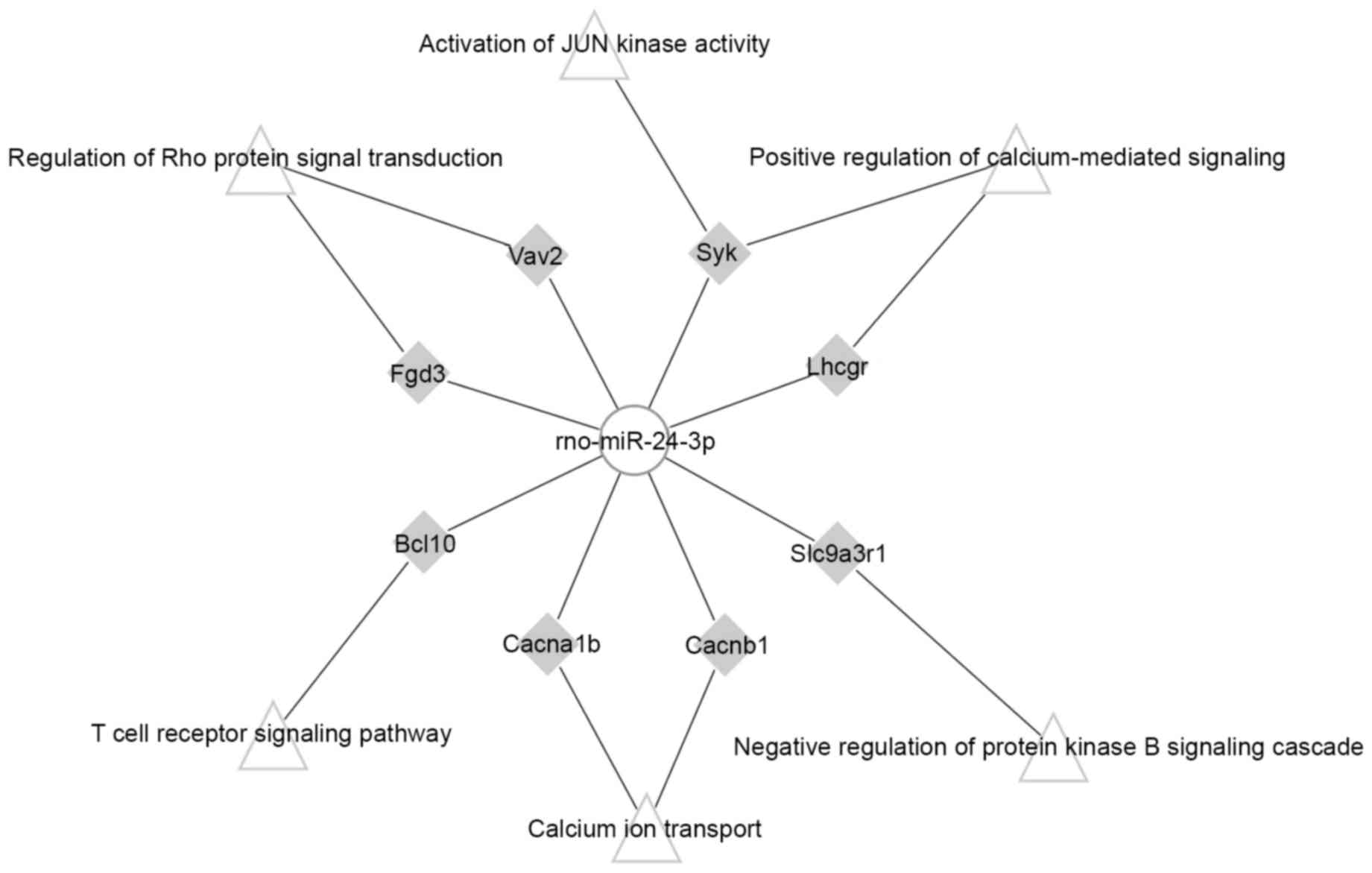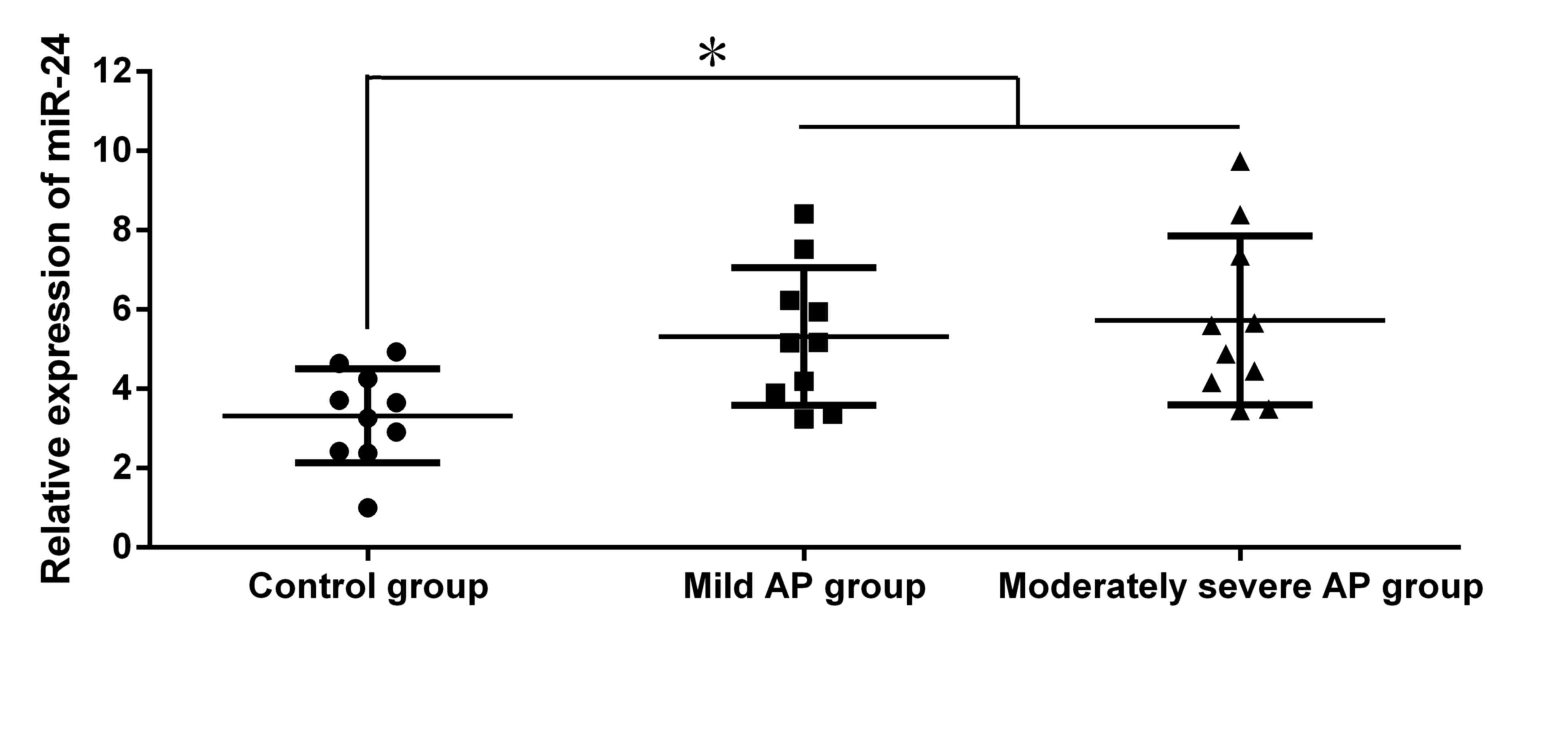|
1
|
An F, Zhan Q, Xia M, Jiang L, Lu G, Huang
M, Guo J and Liu S: From moderately severe to severe
hypertriglyceridemia induced acute pancreatitis: Circulating miRNAs
play role as potential biomarkers. PLoS One. 9:e1110582014.
View Article : Google Scholar : PubMed/NCBI
|
|
2
|
Goodwin D, Rosenzweig B, Zhang J, Xu L,
Stewart S, Thompson K and Rouse R: Evaluation of miR-216a and
miR-217 as potential biomarkers of acute pancreatic injury in rats
and mice. Biomarkers. 19:517–529. 2014. View Article : Google Scholar : PubMed/NCBI
|
|
3
|
Qin T, Fu Q, Pan YF, Liu CJ, Wang YZ, Hu
MX, Tang Q and Zhang HW: Expressions of miR-22 and miR-135a in
acute pancreatitis. J Huazhong Univ Sci Technolog Med Sci.
34:225–233. 2014. View Article : Google Scholar : PubMed/NCBI
|
|
4
|
Huan C, Kim D, Ou P, Alfonso A and Stanek
A: Mechanisms of interleukin-22′s beneficial effects in acute
pancreatitis. World J Gastrointest Pathophysiol. 7:108–116. 2016.
View Article : Google Scholar : PubMed/NCBI
|
|
5
|
Liang X, Zhang B, Chen Q, Zhang J, Lei B,
Li B, Wei Y, Zhai R, Liang Z, He S and Tang B: The mechanism
underlying alpinetin-mediated alleviation of
pancreatitis-associated lung injury through upregulating
aquaporin-1. Drug Des Devel Ther. 10:841–850. 2016.PubMed/NCBI
|
|
6
|
Shi C, Andersson R, Zhao X and Wang X:
Potential role of reactive oxygen species in
pancreatitis-associated multiple organ dysfunction. Pancreatology.
5:492–500. 2005. View Article : Google Scholar : PubMed/NCBI
|
|
7
|
Araki Y, Andoh A, Yokono T, Asano N,
Yoshikawa K, Bamba S, Ishizuka I and Fujiyama Y: The free radical
scavenger edaravone suppresses experimental closed duodenal
loop-induced acute pancreatitis in rats. Int J Mol Med. 12:121–124.
2003.PubMed/NCBI
|
|
8
|
Wang H, Jiang Y, Lu M, Sun B, Qiao X, Xue
D and Zhang W: STX12 lncRNA/miR-148a/SMAD5 participate in the
regulation of pancreatic stellate cell activation through a
mechanism involving competing endogenous RNA. Pancreatology.
17:237–246. 2017. View Article : Google Scholar : PubMed/NCBI
|
|
9
|
Zhao Y, Wang H, Lu M, Qiao X, Sun B, Zhang
W and Xue D: Pancreatic acinar cells employ miRNAs as mediators of
intercellular communication to participate in the regulation of
pancreatitis-associated macrophage activation. Mediators Inflamm.
2016:63404572016. View Article : Google Scholar : PubMed/NCBI
|
|
10
|
Bolstad BM, Irizarry RA, Astrand M and
Speed TP: A comparison of normalization methods for high density
oligonucleotide array data based on variance and bias.
Bioinformatics. 19:185–193. 2003. View Article : Google Scholar : PubMed/NCBI
|
|
11
|
Blenkiron C, Askelund KJ, Shanbhag ST,
Chakraborty M, Petrov MS, Delahunt B, Windsor JA and Phillips AR:
MicroRNAs in mesenteric lymph and plasma during acute pancreatitis.
Ann Surg. 260:341–347. 2014. View Article : Google Scholar : PubMed/NCBI
|
|
12
|
Ashburner M, Ball CA, Blake JA, Botstein
D, Butler H, Cherry JM, Davis AP, Dolinski K, Dwight SS, Eppig JT,
et al: Gene ontology: Tool for the unification of biology. The Gene
Ontology Consortium. Nat Genet. 25:25–29. 2000. View Article : Google Scholar : PubMed/NCBI
|
|
13
|
Shannon P, Markiel A, Ozier O, Baliga NS,
Wang JT, Ramage D, Amin N, Schwikowski B and Ideker T: Cytoscape: A
software environment for integrated models of biomolecular
interaction networks. Genome Res. 13:2498–2504. 2003. View Article : Google Scholar : PubMed/NCBI
|
|
14
|
Jiao X, Sherman BT, da W Huang, Stephens
R, Baseler MW, Lane HC and Lempicki RA: DAVID-WS: A stateful web
service to facilitate gene/protein list analysis. Bioinformatics.
28:1805–1806. 2012. View Article : Google Scholar : PubMed/NCBI
|
|
15
|
Balthazar EJ: Acute pancreatitis:
Assessment of severity with clinical and CT evaluation. Radiology.
223:603–613. 2002. View Article : Google Scholar : PubMed/NCBI
|
|
16
|
Council for International Organizations of
Medical Sciences, . International ethical guidelines for biomedical
research involving human subjects. Bull Med Ethics. 1–23. 2002.
|
|
17
|
Gao X, Gulari E and Zhou X: In situ
synthesis of oligonucleotide microarrays. Biopolymers. 73:579–596.
2004. View Article : Google Scholar : PubMed/NCBI
|
|
18
|
Kang X, Wang LZ, Wang YG, Liu L, Fan ZW,
Bai LZ and Lu XG: Expression and significance of
phosphatidylinositol 3-kinase/protein kinase B signal transduction
pathway in severe acute pancreatitis-associated lung injury.
Zhonghua Yi Xue Za Zhi. 90:732–737. 2010.(In Chinese). PubMed/NCBI
|
|
19
|
Usborne AL, Smith AT, Engle SK, Watson DE,
Sullivan JM and Walgren JL: Biomarkers of exocrine pancreatic
injury in 2 rat acute pancreatitis models. Toxicol Pathol.
42:195–203. 2014. View Article : Google Scholar : PubMed/NCBI
|
|
20
|
Lee EJ, Gusev Y, Jiang J, Nuovo GJ, Lerner
MR, Frankel WL, Morgan DL, Postier RG, Brackett DJ and Schmittgen
TD: Expression profiling identifies microRNA signature in
pancreatic cancer. Int J Cancer. 120:1046–1054. 2007. View Article : Google Scholar : PubMed/NCBI
|
|
21
|
Kuśnierz-Cabala B, Nowak E, Sporek M,
Kowalik A, Kuźniewski M, Enguita FJ and Stepien E: Serum levels of
unique miR-551-5p and endothelial-specific miR-126a-5p allow
discrimination of patients in the early phase of acute
pancreatitis. Pancreatology. 15:344–351. 2015. View Article : Google Scholar : PubMed/NCBI
|
|
22
|
Jeyaseelan K, Lim KY and Armugam A:
MicroRNA expression in the blood and brain of rats subjected to
transient focal ischemia by middle cerebral artery occlusion.
Stroke. 39:959–966. 2008. View Article : Google Scholar : PubMed/NCBI
|
|
23
|
Hamada S, Masamune A, Kanno A and
Shimosegawa T: Comprehensive analysis of serum microRNAs in
autoimmune pancreatitis. Digestion. 91:263–271. 2015. View Article : Google Scholar : PubMed/NCBI
|
|
24
|
Di Gregoli K, Jenkins N, Salter R, White
S, Newby AC and Johnson JL: MicroRNA-24 regulates macrophage
behavior and retards atherosclerosis. Arterioscler Thromb Vasc
Biol. 34:1990–2000. 2014. View Article : Google Scholar : PubMed/NCBI
|
|
25
|
Katoh M: Therapeutics targeting
angiogenesis: Genetics and epigenetics, extracellular miRNAs and
signaling networks (Review). Int J Mol Med. 32:763–767. 2013.
View Article : Google Scholar : PubMed/NCBI
|
|
26
|
Lakkaraju A and Rodriguez-Boulan E:
Itinerant exosomes: Emerging roles in cell and tissue polarity.
Trends Cell Biol. 18:199–209. 2008. View Article : Google Scholar : PubMed/NCBI
|
|
27
|
Zhang Y, Wu XH, Luo CL, Zhang JM, He BC
and Chen G: Interleukin-12-anchored exosomes increase cytotoxicity
of T lymphocytes by reversing the JAK/STAT pathway impaired by
tumor-derived exosomes. Int J Mol Med. 25:695–700. 2010.PubMed/NCBI
|
|
28
|
Valadi H, Ekström K, Bossios A, Sjostrand
M, Lee JJ and Lötvall JO: Exosome-mediated transfer of mRNAs and
microRNAs is a novel mechanism of genetic exchange between cells.
Nat Cell Biol. 9:654–659. 2007. View
Article : Google Scholar : PubMed/NCBI
|
|
29
|
Hunter MP, Ismail N, Zhang X, Aguda BD,
Lee EJ, Yu L, Xiao T, Schafer J, Lee ML, Schmittgen TD, et al:
Detection of microRNA expression in human peripheral blood
microvesicles. PLoS One. 3:e36942008. View Article : Google Scholar : PubMed/NCBI
|
|
30
|
Kylänpää ML, Repo H and Puolakkainen PA:
Inflammation and immunosuppression in severe acute pancreatitis.
World J Gastroenterol. 16:2867–2872. 2010. View Article : Google Scholar : PubMed/NCBI
|
|
31
|
Maegdefessel L, Spin JM, Raaz U, Eken SM,
Toh R, Azuma J, Adam M, Nakagami F, Heymann HM, Chernogubova E, et
al: miR-24 limits aortic vascular inflammation and murine abdominal
aneurysm development. Nat Commun. 5:52142014. View Article : Google Scholar : PubMed/NCBI
|
|
32
|
Fanous MY, Phillips AJ and Windsor JA:
Mesenteric lymph: The bridge to future management of critical
illness. JOP. 8:374–399. 2007.PubMed/NCBI
|
|
33
|
Flint RS, Phillips AR, Power SE, Dunbar
PR, Brown C, Delahunt B, Cooper GJ and Windsor JA: Acute
pancreatitis severity is exacerbated by intestinal
ischemia-reperfusion conditioned mesenteric lymph. Surgery.
143:404–413. 2008. View Article : Google Scholar : PubMed/NCBI
|
|
34
|
Endo K, Weng H, Kito N, Fukushima Y and
Iwai N: MiR-216a and miR-216b as markers for acute phased
pancreatic injury. Biomed Res. 34:179–188. 2013. View Article : Google Scholar : PubMed/NCBI
|
|
35
|
Kylanpaa L, Rakonczay Z Jr and O'Reilly
DA: The clinical course of acute pancreatitis and the inflammatory
mediators that drive it. Int J Inflam. 2012:3606852012. View Article : Google Scholar : PubMed/NCBI
|
|
36
|
Ohmoto K and Yamamoto S: Serum
interleukin-6 and interleukin-10 in patients with acute
pancreatitis: Clinical implications. Hepatogastroenterology.
52:990–994. 2005.PubMed/NCBI
|
|
37
|
Liu Y, Zhou D, Long FW, Chen KL, Yang HW,
Lv ZY, Zhou B, Peng ZH, Sun XF, Li Y and Zhou ZG: Resolvin D1
protects against inflammation in experimental acute pancreatitis
and associated lung injury. Am J Physiol Gastrointest Liver
Physiol. 310:G303–G309. 2016. View Article : Google Scholar : PubMed/NCBI
|
|
38
|
Tran TH, Krishnan S and Amiji MM:
MicroRNA-223 induced repolarization of peritoneal macrophages using
CD44 targeting hyaluronic acid nanoparticles for anti-inflammatory
effects. PLoS One. 11:e01520242016. View Article : Google Scholar : PubMed/NCBI
|
|
39
|
Curtale G, Mirolo M, Renzi TA, Rossato M,
Bazzoni F and Locati M: Negative regulation of Toll-like receptor 4
signaling by IL-10-dependent microRNA-146b. Proc Natl Acad Sci USA.
110:11499–11504. 2013; View Article : Google Scholar : PubMed/NCBI
|
|
40
|
Awla D, Hartman H, Abdulla A, Zhang S,
Rahman M, Regnèr S and Thorlacius H: Rho-kinase signalling
regulates trypsinogen activation and tissue damage in severe acute
pancreatitis. Br J Pharmacol. 162:648–658. 2011. View Article : Google Scholar : PubMed/NCBI
|
|
41
|
Bae GS, Heo KH, Park KC, Choi SB, Jo IJ,
Seo SH, Kim DG, Shin JY, Kang DG, Lee HS, et al: Apamin attenuated
cerulein-induced acute pancreatitis by inhibition of JNK pathway in
mice. Dig Dis Sci. 58:2908–2917. 2013. View Article : Google Scholar : PubMed/NCBI
|
|
42
|
Ramnath RD, Sun J and Bhatia M: Role of
calcium in substance P-induced chemokine synthesis in mouse
pancreatic acinar cells. Br J Pharmacol. 154:1339–1348. 2008.
View Article : Google Scholar : PubMed/NCBI
|
|
43
|
Xue P, Deng LH, Zhang ZD, Yang XN, Xia Q,
Xiang DK, Huang L and Wan MH: Effect of Chaiqinchengqi decoction on
sarco/endoplasmic reticulum Ca2+-ATPase mRNA expression
of pancreatic tissues in acute pancreatitis rats. World J
Gastroenterol. 14:2343–2348. 2008. View Article : Google Scholar : PubMed/NCBI
|
|
44
|
Fordham JB, Naqvi AR and Nares S: miR-24
regulates macrophage polarization and plasticity. J Clin Cell
Immunol. 6:pii:3622015.
|
|
45
|
Zhu Y, You W, Wang H, Li Y, Qiao N, Shi Y,
Zhang C, Bleich D and Han X: MicroRNA-24/MODY gene regulatory
pathway mediates pancreatic β-cell dysfunction. Diabetes.
62:3194–3206. 2013. View Article : Google Scholar : PubMed/NCBI
|













